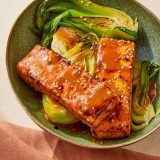Tofu’s sponge-like texture is great for soaking up flavor. It also is good at retaining the water tofu typically is packaged in. Conventional wisdom is that this water can dilute flavors and prevent browning. This is why many recipes call for pressing tofu to extract excess moisture before cooking it. There are multiple ways to do this; we wondered which worked best.
Using full blocks of extra-firm tofu, we put several methods to the test, including wrapping the block of tofu in paper towels and pressing it under a plate weighted with canned foods; using a tofu press, typically a spring-loaded device that compresses blocks of tofu; and skipping the pressing entirely and simply patting the block dry.
After 30 minutes, the two pressing methods were roughly equal, with the tofu press removing just slightly more water at 3¾ ounces compared to 3½ ounces with the canned foods. The tofu press sample did have a slightly meatier texture, which we liked when broiled. In stir-fries, we preferred the somewhat creamier texture of the can-pressed sample. But in both cases, the tofu browned and crisped as desired.
The real surprise was the tofu we didn’t press and only patted dry. It performed fairly well in all tests, holding up to the rigors of stir-frying and retaining a creamy texture. It didn’t brown quite as well as the pressed samples, but it still was good. Also, we found that dredging the unpressed tofu in cornstarch before cooking created a slurry-like coating that crisped perfectly.
Our conclusion: If a meatier texture and perfect browning is key, press your tofu. But in many cases, you can save the time and won’t be disappointed by simply patting it dry.
Tofu: To Press or to Pat?
Pressing tofu—either with a tofu press or weighed down—gives it a firmer texture.
Photo: Joe Murphy; Styling: Wes Martin








